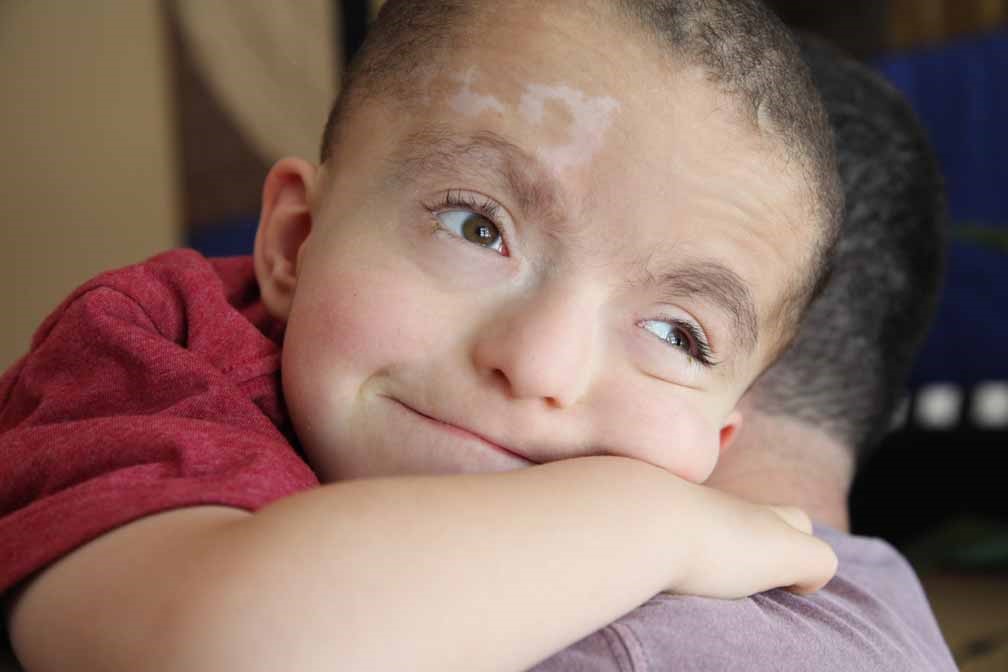
Rare diseases: Pallister-Killian syndrome
Pallister-Killian syndrome is a rare disease. The symptoms are highly variable. Neuromotor and psychic development can be impaired
Pallister-Killian syndrome is a rare disease caused by a chromosome abnormality and present from birth
In its typical form it is characterised by:
- Abnormal decrease in muscle tone (hypotonia);
- Delay in reaching motor milestones such as sitting or taking the first steps;
- Psychomotor retardation;
- Diaphragmatic hernia;
- Alterations in skin colour (skin dyschromia);
- Coarse facial features.
The syndrome was described independently by Pallister in 1977 and by Teschler and Killian in 1981.
It was not until 2003, however, that Pallister discovered that the disease is caused by a chromosome abnormality.
It is believed that this disease occurs in 1 in 25,000 births.
But this is probably an underestimate as cases with milder symptoms often go undiagnosed.
The syndrome is not hereditary and occurs purely by chance: the parents of a child with Pallister-Killian syndrome have normal chromosomes and all cases observed so far are sporadic and not familial.
This is a chance event, a genuine error that occurs during the formation of reproductive cells (usually oocytes).
The disease is caused by tetrasomy of the short arm of chromosome number 12: there are 4 copies of the short arm of chromosome 12 instead of the usual 2 copies.
This chromosomal alteration is generally mosaic, i.e. only present in one part of the body’s cells
The other cells have the usual 2 copies of the short arm.
Usually the two supernumerary short arms are of maternal origin and join together to form an isochromosome in supernumerary to the usual 23 pairs of chromosomes.
The symptoms of Pallister-Killian syndrome vary greatly from one child to another
The severity of each symptom is also very variable.
The main features are:
A) Typical changes in facial shape such as:
- Coarse facial features;
- Flat profile;
- High forehead with balding of the forehead and sides of the head;
- Sparse eyelashes and eyebrows;
- Eyelids turned upwards and outwards;
- Eyes widely spaced apart (hypertelorism);
- Flat and wide root of the nose;
- Short nose with nostrils tilted forward;
- Wide mouth with downward angles and protruding upper lip.
- Abnormal decrease in muscle tone (hypotonia);
B) Delay in reaching motor milestones such as sitting or taking the first steps;
C) Congenital malformations such as diaphragmatic hernia, anal malformations, congenital heart disease;
D) Psychomotor retardation with delayed language development;
E) Short arms and thighs;
F) Small hands and feet with poorly developed nails (hypoplastic);
G) Congenital deafness;
H) Alterations in skin colour with pale streaks (hypoplasia).
Macroglossia (large, thick, protruded tongue), joint contractures and epileptic seizures may also occur over time.
Many patients manifest difficulties with feeding, swallowing and chewing.
Some children have very low levels of mosaicism
In other words, only a few of their cells have 4 copies of the short arm of chromosome number 12 while most cells have, as usual, only 2 copies of the short arm.
These children can present very mild symptoms.In some cases, Pallister-Killian syndrome may be suspected before birth when the second trimester prenatal screening ultrasound reveals abnormalities or malformations such as diaphragmatic hernia or congenital heart disease.
In such cases, amniocentesis or chorionic villus sampling may allow the diagnosis to be confirmed.
After birth, the diagnosis is based first of all on a careful collection of the baby’s history and a thorough medical examination.
The diagnosis is confirmed when karyotype analysis shows the presence of isochromosome 12p, which, as mentioned above, results from the union of the two supernumerary short arms of chromosome number 12.
Early clinical suspicion, based on the recognition of typical symptoms, is also extremely important for diagnosis.
In fact, isochromosome 12p is usually not present in the blood cells – lymphocytes – that are usually used for karyotype analysis.
To find the supernumerary isochromosome in Pallister-Killian syndrome it is necessary to take fibroblasts with a skin biopsy
The percentage of mosaicism (number of pathological cells/number of cells with normal karyotype x 100) can vary from 30 to 95% of the fibroblasts.
To confirm that the supernumerary chromosome is indeed isochromosome 12p, the FISH technique (in situ hybridisation with DNA probes specific to chromosome 12) can be used.
This type of technique can also be used on a buccal smear (collection of oral mucosal flaking cells by rubbing a special swab (buccal swab) on the inside walls of the mouth) for a rapid preliminary diagnosis.
Treatment of Pallister-Killian syndrome is symptomatic and rehabilitative
Depending on the child’s problems, therapy may include:
- Surgical treatment of malformations, generally in the first months of life;
- Neuro-psycho-motor rehabilitation treatment with early intervention programmes;
- Naso-gastric tube or other bowel access for enteral nutrition in children with feeding difficulties.
- The majority of children with Pallister-Killian syndrome need long-term care and assistance
They can attend school with the help of family members and supportive teachers while coping with the problems of all children with chronic illnesses.
It must be expected that they will also need family support as adults.
Read Also
Emergency Live Even More…Live: Download The New Free App Of Your Newspaper For IOS And Android
Rare Diseases: Russian Economist Anatoly Chubais Diagnosed With Guillain Barré Syndrome
Ultrarare Diseases: First Guidelines For Malan Syndrome Published
Rare Diseases: Von Hippel-Lindau Syndrome
Zika Linked To Guillain-Barre Syndrome In New Study
Rare Diseases: Septo-Optic Dysplasia
Rare Diseases: Congenital Hyperinsulinism
Foot Deformities: Metatarsus Adductus Or Metatarsus Varus
Progeria: What Is It, Symptoms, Causes, Diagnosis And Possible Treatment
Rare Diseases: Rothmund-Thomson Syndrome


